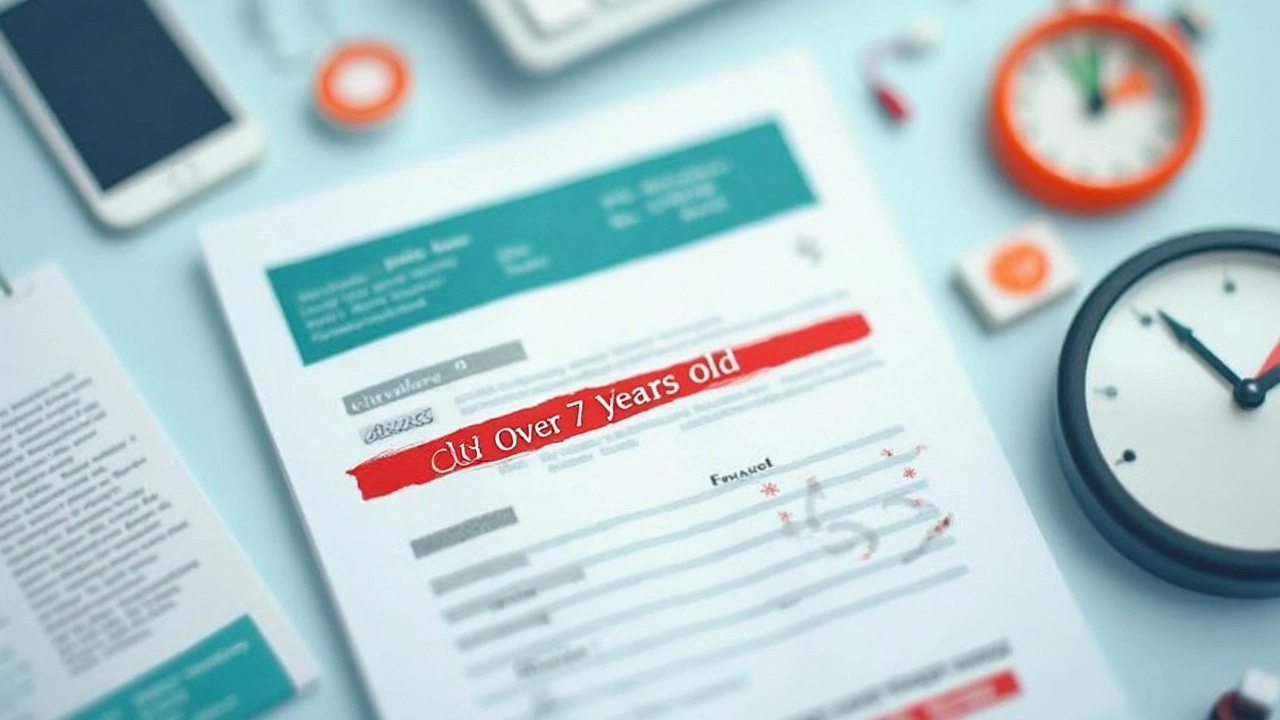If you've been dodging an old debt for years, you're probably hoping it'll just disappear. Lots of folks talk about this '7-year rule,' and it sounds like magic—just wait long enough, and your debt is gone, right? Not so fast. The real story behind what happens after seven years of not paying debt isn't as simple as people make it out to be.
First off, the biggest thing that changes after seven years is on your credit report. Negative marks like missed payments, charge-offs, and collections usually drop off your credit history around that time, which can help your credit score breathe a little. But here's the catch: just because the debt vanishes from your credit report doesn’t mean you’re totally off the hook. Debt collectors might still contact you, and some types of debt can come back to haunt you in unexpected ways.
If you've been thinking about just waiting it out, you should know what actually happens after that 7-year line is crossed—and what doesn't. There's more to it than most people realize. Ready to find out what really happens, what’s just myth, and how you can actually start getting out from under old debts for good? Let’s dig into the facts.
- How Debt Impacts Your Credit Report Over Time
- The Truth About the 7-Year Rule
- Debt Collectors: Can They Still Come After You?
- Legal Risks and the Statute of Limitations
- Best Moves for Handling Old Debts
How Debt Impacts Your Credit Report Over Time
Your credit report acts like a report card for your borrowing history. When you stop paying a bill—whether it’s a credit card, loan, or even a medical bill—the clock starts ticking on how long that negative mark will show up.
Miss a payment by 30 days? Your lender will report it, and your credit score drops. But the trouble doesn't stop there. If you keep missing payments, it goes from a late payment, to a default, to a charge-off, and maybe even to collections. Each stage drags your score down more, and these negative records can stick around for a while.
- Late payments: Show up for up to seven years from when you first missed the payment.
- Collections: If the debt gets sent to a collection agency, that collection account also stamps itself onto your credit report for seven years.
- Charge-offs: Lenders write off your debt as a loss, but this isn’t a free pass—it’s another deep scratch on your report for seven years.
It's worth noting that the seven-year timeline usually starts from the date you first fell behind, not from when the account officially went into collections or was charged off. So, the original date of delinquency is what really matters here.
If you’re waiting out old debt, you might see that debt start to fall off your report after seven years, but until then, lenders, landlords, and even some employers might see your rocky payment history. The older the negative record, the less impact it has on your score, but it's still there for anyone checking your report.
Pro tip: Regularly check your credit report for free at AnnualCreditReport.com. Catch errors or outdated info so bad debt doesn’t stick around longer than it should.
The Truth About the 7-Year Rule
The "7-year rule" confuses a lot of people. Here’s the real deal: after seven years, most negative info—like late payments, collections, or charge-offs—must be removed from your credit report under the Fair Credit Reporting Act (FCRA). So if you’ve missed payments or stopped paying a loan, those bad marks are supposed to come off your record after seven years.
This rule applies to almost all types of personal debt, like credit cards, personal loans, and auto loans. Tax liens, bankruptcies, or certain court judgments might stick around longer, but for basic stuff, the seven-year rule is solid.
| Type of Negative Info | Time on Credit Report |
|---|---|
| Late Payments | 7 Years |
| Collections | 7 Years |
| Charged-Off Accounts | 7 Years |
| Bankruptcy (Chapter 7) | 10 Years |
| Bankruptcy (Chapter 13) | 7 Years |
| Civil Judgments | 7 Years |
Here’s the important part: The clock starts ticking from the date you first missed a payment, not the day the account was sent to collections. If you keep making small payments, or agree to a payment plan, it could restart the clock and leave the negative info on your report longer. That’s a huge thing to watch out for if you’re hoping to let old debt drop off your credit.
- Only old debts removed from your credit report won’t affect your debt score anymore, but you still legally owe the money until the statute of limitations runs out.
- Don’t confuse credit reporting limits with how long a debt collector can sue you (that’s a totally separate rule—more on that later).
- Credit reporting agencies aren’t perfect. Sometimes they leave stuff on your report past the seven years. You can dispute it and get it cleaned up for free.
If you’re banking on the 7-year rule, keep detailed records of when you missed your first payment and check your credit reports regularly. Services like AnnualCreditReport.com let you check your reports from the three big credit bureaus every year for free. Catch errors early, and you’re way less likely to get tripped up by outdated info.

Debt Collectors: Can They Still Come After You?
So here’s the million-dollar question: After seven years, can debt collectors still come knocking? The short answer is yes, but things do change. Just because a debt drops off your credit report doesn’t mean collectors magically stop contacting you. They can still try to collect on what you owe for as long as the debt exists, even if it’s no longer dragging down your credit report.
The main thing that changes after seven years is visibility on your credit. For most debts, collectors can legally call, send letters, or email you until the debt is paid or settled. But the older the debt, the less leverage they really have—especially if it’s past the “statute of limitations.” This is the time period when a collector can sue you to get a court judgment. It varies a lot depending on where you live and the type of debt. In some states, it could be as short as three years; in others, it stretches up to ten.
Check out how the statute of limitations looks for some states and debt types:
| State | Credit Card Debt | Medical Debt | Auto Loan Debt |
|---|---|---|---|
| California | 4 years | 4 years | 4 years |
| Texas | 4 years | 4 years | 4 years |
| New York | 6 years | 6 years | 4 years |
Keep in mind, even after this time is up, collectors can still ask you to pay. They just can’t take you to court to force payment. Some might not tell you that the debt is uncollectible by law, so always ask direct questions if you’re contacted about really old debt. Never agree to make a small payment or promise to pay without knowing if the statute of limitations has passed. Doing that can restart the clock and make the debt legally collectible all over again.
If collectors are bothering you about a debt that's older than your state's time limit, you’ve got rights. You can ask them to stop contacting you in writing, and you can also dispute the debt if you think it's been reported incorrectly. Check your state laws or talk to a nonprofit credit counselor to get a grip on your situation before you respond.
Legal Risks and the Statute of Limitations
This is where things get real. Just because a debt drops off your credit report after seven years doesn't mean collectors totally lose interest. Every state has something called a statute of limitations, which is basically a countdown timer. Once time's up, a collector can't legally sue you for that debt. But here's the kicker—the countdown doesn't always match the 7-year mark everyone talks about.
The statute of limitations can be anywhere from 3 to 10 years, depending on your state and the type of debt. For example, credit card debt in California has a 4-year limit, but in Rhode Island, it's 10 years. That means you could still be sued, even after your debt drops off your credit report, if your state's limit is longer than seven years.
| State | Credit Card Debt (Years) |
|---|---|
| California | 4 |
| Texas | 4 |
| Florida | 5 |
| Rhode Island | 10 |
Now, the moment the statute of limitations expires, collectors can’t win a lawsuit against you. But they can still call, send letters, or try to get you to pay up. Here’s the big mistake people make—if you make a payment or even admit in writing that you owe the debt, you can actually restart the timer in some states. That’s called “re-aging” the debt, and it gives collectors another shot to sue you.
- If you get a lawsuit for an old debt, don’t just ignore it. Respond in writing and mention if you believe the debt is past the statute of limitations.
- Before making any payment or promise, check your state’s law and the date you last paid.
- Be careful with what you say to collectors—keep things short, don’t admit to the debt, and ask for proof if you’re unsure.
Statutes of limitations really matter if you’re worried about lawsuits. They don’t erase the debt, but they do limit collectors’ power in court. If you’re unsure, talking to a consumer lawyer or checking your state attorney general’s website can save you a lot of grief.

Best Moves for Handling Old Debts
Old debts hanging over your head? Ignoring them just gives you more anxiety. The good news: once you’ve hit that 7-year mark, you have a few smart options. Each one comes with pros, cons, and a few traps to avoid. Here’s what really matters when you want to handle old debt the right way.
First off, check your credit report. Even if you think a debt should drop off after seven years, mistakes happen. According to the Consumer Financial Protection Bureau, over a third of people spot errors when they pull their credit report for free at AnnualCreditReport.com. If an old debt is still showing up past its expiration, file a dispute—credit bureaus have 30 days to investigate and fix anything they can’t verify.
Now, let’s talk debt collectors. Technically, after the statute of limitations runs out (which isn’t always exactly 7 years; it depends on your state and type of debt), collectors can’t force you to pay through the courts. But they might still call, send letters, or even offer a settlement. If you decide to pay or negotiate, get everything in writing before you send money. Otherwise, you could accidentally restart the clock, making your debt legally collectible again.
- Always get proof of the debt before making agreements. Some collectors chase debts that aren’t even valid anymore.
- Don’t ever give a collector your bank account details unless you’ve agreed to a written deal and verified their legitimacy.
- Consider sending a "cease and desist" letter if collectors won’t leave you alone after the statute of limitations.
- If you’re overwhelmed or if you have multiple old debts, look into debt consolidation. Services like debt management plans can combine payments and sometimes reduce overall interest, making everything way easier to handle.
For those who want the data, here’s a quick look at the statute of limitations on debt in different states (rounded examples):
| State | Statute of Limitations (Years) |
|---|---|
| California | 4 |
| Texas | 4 |
| New York | 6 |
| Florida | 5 |
| Illinois | 5 |
One last tip: don’t let shame keep you from getting advice. Financial counselors or legit debt consolidation agencies (look for ones accredited by the National Foundation for Credit Counseling) can walk you through the best choices for wiping out those zombie debts for good.

